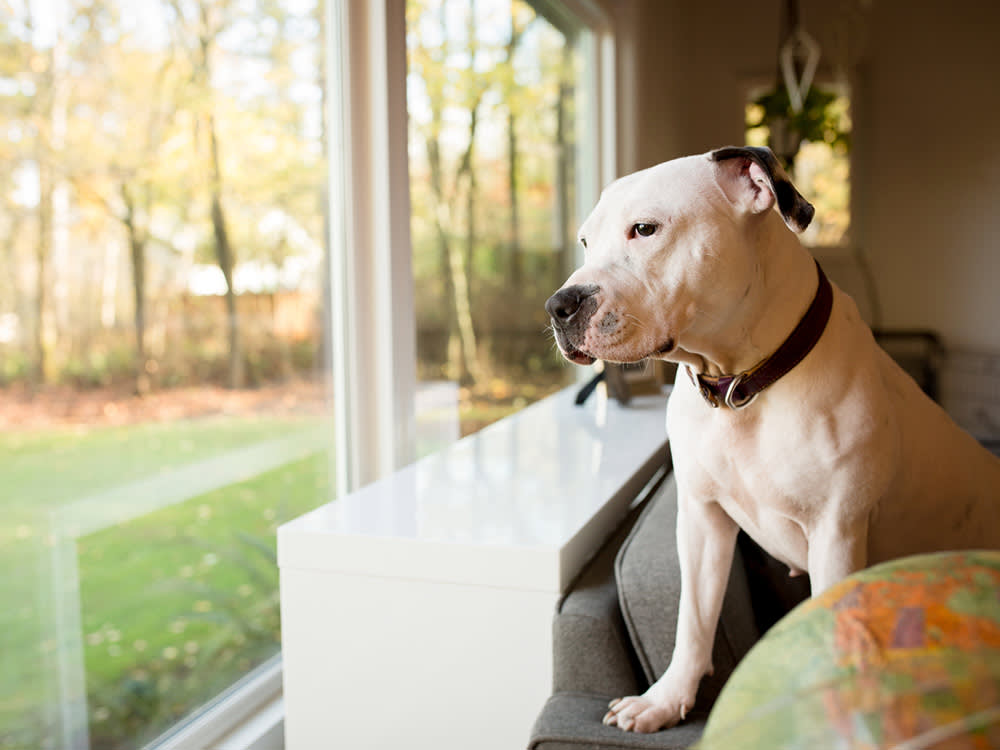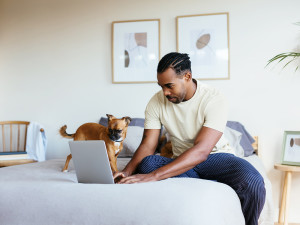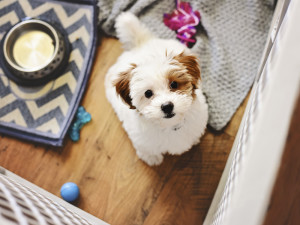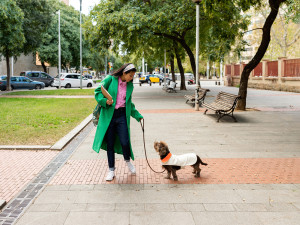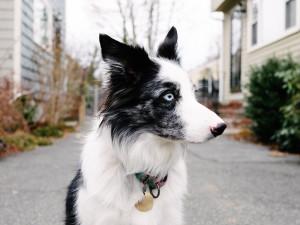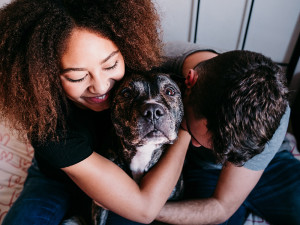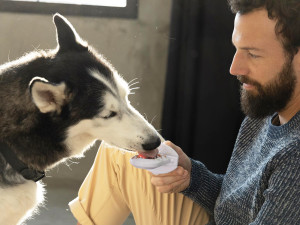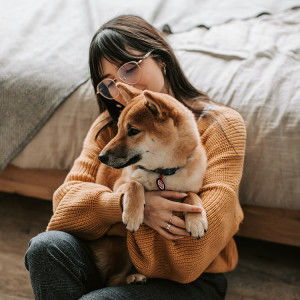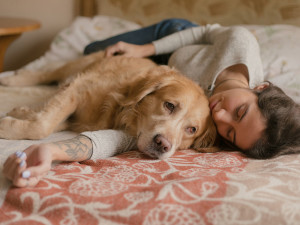Separation Anxiety in Dogs
Does your dog freak out when you head for the door? Here’s some advice.
In This Article:
What Is Separation Anxiety? What Are the Causes of Separation Anxiety in Dogs? Symptoms of Separation Anxiety in Dogs What Are the Different Types of Separation Anxiety in Dogs? How Do I Help My Dog? How Do I Prevent Separation Anxiety From Developing? Frequently Asked Questions
Obviously, all we ever want to do is stay home cuddling our perfect pups. But sometimes, life gets in the way, and we have to leave our pets behind for pesky things like work, grocery runs, or (cover your dog’s eyes) canine-free travel. And as hard as it is for us to leave those puppy eyes at the door, it can be even harder for our pets — particularly those who suffer from separation anxiety.
First things first: What is separation anxiety in dogs?
In a nutshell, separation anxiety occurs when a dog experiences fear or panic when they’re left alone. Sometimes, it’s triggered by a specific person leaving the house; other times, it happens when anyone leaves. Common signs of separation anxiety include barking, panting, drooling, destroying furniture, peeing or pooping in the house, pacing, or an inability to settle down.
Why your dog finds it hard to be alone
Keep in mind that separation anxiety isn’t your dog’s fault. They have become separated from their support and social group, which can cause significant stress and even fear (for humans as well). Their actions aren’t a way to get back at you; instead, they are normal responses to stress and anxiety. Rather than blaming your dog, try to remain patient and understanding when helping them manage it.
How much do you spend on your pet per year?
What are the causes of separation anxiety in dogs?
It’s hard to know the exact causes of separation anxiety in dogs, but it usually has to do with major life changes. For example, a change in family (if your pup was rescued or adopted) or a change in their environment (if you moved from one house to another or went back to work).
Another stressor could be the sudden absence of a pet parent, whether from a divorce or a death in the family. Loneliness, boredom, and old age can also cause separation anxiety in dogs. Don’t forget past experiences can weigh in as well. If they were abandoned, for example, their new human leaving may dredge up negative memories.
Symptoms of separation anxiety
Every dog is going to respond to stress differently (sounds pretty familiar, right?). Some will start showing these signs while you’re getting ready because they know what’s coming. Others may only start to get upset after you’ve left, which may mean you have to watch them howl or cry on the pet or nanny cam. Some of the signs can include:
Lethargy or withdrawal
Not eating
Clinginess
Panting, pacing, or drooling
Trembling, shivering
Howling, barking, whining
Chewing, scratching, or destroying items in your home
Self-destruction
Urinating or defecating in the house
What are the different types of separation anxiety in dogs?
There aren’t specific types of separation anxiety in dogs, but research showsopens in new tab that there are four underlying frustrations that could be causing your dog’s anxiety. The four main forms of distress are: wanting to get to something outside, wanting to get away from something in the house, reacting to outside events or noises, and severe boredom. The researchers note that getting to the root of the problem can help you treat your dog more effectively.
Now this is stressing me out. How do I help my dog?
The best-case scenario, at least if you ask your dog, is for you to literally never leave the house without them again. (But they might say that even if they don’t have separation anxiety.) The next best thing is to try to address symptoms of separation anxiety while you’re able to spend time at home.
Start by paying attention to how your dog acts when you’re getting ready to leave the house. Look for signs that include pacing, panting, pulling their ears back, following you around, hiding, and — the ultimate sign that something is wrong — refusing treats. Also, check to see if your dog seems panicked when you close a door between you and them or leave the house briefly to take out the garbage. These are all signs of distress.
If you can’t tell if your dog is acting fearful or anxious, a little spying can come in handy. Try leaving your pup home for very short periods while watching them through a webcam to see how they react while you’re out. Not only can you get a good look at their behavior, but you may also be able to tell if there are any other triggers (loud noises, Amazon drivers dropping off yet another package at the door) contributing to the problem.
What can I do to relieve anxiety (mine and my dog’s)?
Separation anxiety is tough — for both of you. Your dog is upset, and you’re upset that your dog is upset. It’s all very upsetting. Luckily, there are a few steps you can take to train your pup to be more comfortable with being left alone.
Establish a routine.
Dogs are big fans of routines. Routines help them understand what you expect of them and what they can expect from their day. Set a morning schedule for activities such as feeding, potty breaks, and playtime or walks. This allows your dog to predict when they’ll receive your attention and when they’re on their own. They still might not want you to leave the house, but at least they won’t be blindsided when they see you reach for the car keys.
Make sure your dog has a safe and comfortable space.
Everyone loves a cozy nap spot, and dogs are no exception. Create a comfortable, safe place where your dog can chill. Maybe it’s a crate. Maybe it’s a back room of the house. Or — let’s be honest — it might be smack dab in the middle of your bed.
Ease your dog into the situation.
Start training your dog to go to their happy place whenever it’s time to settle down. You can even turn on some music or leave a piece of clothing with your scent on it to help your dog feel at ease. The goal is for your dog to create a positive association with this spot and get used to being there by themselves, even when you’re in the house. Then, when you start to leave, they know they have a place they can go to feel safe and relaxed.
One word of caution: Some dogs who experience severe separation anxiety can panic and attempt to break free from crates — and hurt themselves in the process. So, be sure your dog is comfortable wherever their safe space is, especially if that’s being confined, before leaving them alone.
Make departures as low-key as possible.
Try not to draw attention to the fact that you’re getting ready to leave. If you can, have your dog settle in their happy place while you finish getting ready. Avoid dramatic goodbyes (even though you probably need a hug yourself before heading to work). When it’s time to go, give your dog a long-lasting treat (frozen peanut butter-stuffed Kongs work great) or a toy that will keep them occupied long after you leave the house.
How to manage separation anxiety
If your dog still isn’t into a little alone time, there may be more options. Keep in mind that if your dog is truly miserable being home alone for more than just a few hours, doggie daycare could be a godsend. There, your pup can socialize with people and other pets while getting in their daily exercise to boot. Win-win.
Desensitization
Desensitizationopens in new tab training is a popular method for dogs with fears or phobias. It works by exposing your pup to small doses of what they don’t like, giving them praise and encouragement to show them it’s okay, and rewarding them when they respond appropriately. Exposure is gradually increased until they feel comfortable.
When dealing with separation anxiety, this typically means giving your dog short periods of being alone and rewarding them when they’re calm and collected. This often starts with leaving them alone in a room for a few minutes and then petting them when you return. You can increase these times with short trips outside and then longer trips where you actually leave, showing them that no matter how long you leave for, you’ll always come back.
Positive-reinforcement training
Use this one separately or as part of desensitization. It’s a very flexible training method that simply includes rewarding your dog’s good behavior and ignoring or redirecting the bad. So, when a dog stays calm while you get ready to leave, reward them. If they start to whine or pace, redirect them to their safe place or give them a toy or treat to occupy them and then reward them.
Herbal and natural remedies
Some dogs are just more anxious than others. and even the best training won’t help them stay calm. In these cases, you may need a little herbal support. There are many natural calming aids in many different forms on the market, so be sure to talk to your vet about the ones they deem safe and effective.
Prescription medication
Then there are some dogs whose anxiety doesn’t respond to natural remedies either, so prescription medications may be necessary. Keep in mind: Good medications aren’t sedatives that make your dog seem calm because they feel tired; they help decrease anxiety at the brain level so your dog truly feels better about your departure.
How do I prevent separation anxiety from developing in the first place?
The best way to prevent separation anxiety is to train them from a young age, during puppyhood, but here are some other preventative tips for separation anxiety in dogs:
Meet your dog’s needs.
Make sure your pup has everything they need — physically, socially, and emotionally — so they don’t freak out when you leave the house.
Avoid smothering your dog.
When you’re home with your pup, don’t fuss over them too much. Give them some space. Constant attention will make it harder for your pup when you leave.
Give your pup a treat.
Offer your dog a toy, such as a food puzzle, to work on while you’re gone. It will keep them occupied and lessen their fear of being left alone.
Play calming music.
It might sound silly, but playing some chill tunes, like classical music, may help keep your dog calm when you’re gone all day.
When do I need to bring in the pros?
The sooner, the better. While it may seem like a trainer is the best person to reach out to first, your veterinarian may be the better option. They will be able to diagnose or rule out medical causes for the behavior first.
While your veterinarian can treat any underlying medical issues, a certified trainer or behaviorist can help come up with a plan to teach your dog that being alone doesn’t have to be scary. The recommendations will vary depending on your pet, but if you do use a trainer, be sure to do some research upfront.
Disclaimer alert: This article is here to share information. But, much like pineapple on pizza, the topic may be controversial, meaning that not all vets or pet professionals agree. Every pet has specific needs. So, don’t take this as fact or medical advice. Talk things over with your vet when making decisions, and use your best judgment (about both your pet’s health and pizza toppings).
Bottom line
Separation anxiety is no fun for either you or your dog. Not only does it make it more difficult for you to escape the house, but it can also be detrimental to your dog’s health and your property. Fortunately, there are many methods that can help put your dog more at ease with being alone, and if all else fails, don’t be afraid to reach out to your veterinarian.
FAQs
How long does it take to see improvement in a dog’s separation anxiety?
It depends. Every dog and every situation is different, so it's hard to say how long it will take to see improvement in your dog's separation anxiety.
What are some home remedies for separation anxiety?
Some home remedies for separation anxiety include playing your dog soothing music while you're gone or using a plug-in diffuser, such as Adaptil.
What dog breed has the most separation anxiety?
Though any dog of any breed can develop separation anxiety, Border Collies, Labs, Jack Russell Terriers, and German Shepherds are a few that do so more frequently. This is because they tend to develop strong bonds with their pet parents and require a lot of physical and mental stimulation.
Why do some dogs develop separation anxiety?
There’s no one answer for this – instead, it’s a combination of genetics, past experiences, temperament, and environmental changes that contribute to separation anxiety. It’s typically triggered by a sudden change in routine or environment that throws off their schedule.
References
“Positive Reinforcement Training.” The Humane Society of the United States. https://www.humanesociety.org/resources/positive-reinforcement-trainingopens in new tab.
“Reducing Fear and Stress with Desensitization and Counterconditioning.” VCA Animal Hospitals. https://vcahospitals.com/know-your-pet/overcoming-fears-with-desensitization-and-counterconditioningopens in new tab.
